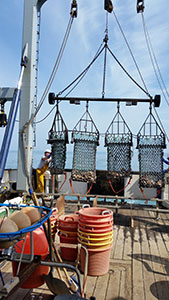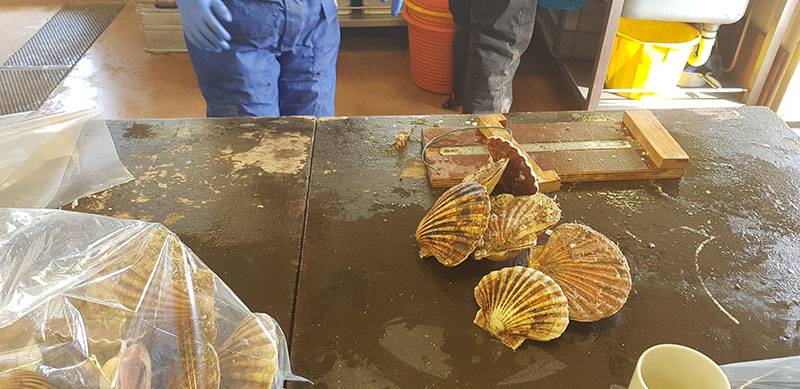 Scallops
Scallops
We will continue to study scallop stock status to provide management plans to ensure sustainable exploitation, but will also increase the collaboration with the fishing industry in participatory research for long-term sustainably.
Work to be undertaken includes:
- Mapping of fishing effort using Vessel Monitoring Systems (VMS) and fisher knowledge
- Scallop stock status surveys with fisher/research vessel comparison
- Catchability trials
- Camera surveys of unexploited broodstock
- Scallop maturity and spawning
This paper analyses differences in commercial vessel scallop catch efficiency, and shows that catch efficiency can be considerably different between commercial vessels and that it is likely problematic to assume equal catch rates between commercial vessels for the purpose of stock assessment. Catch efficiency is the fraction of scallops caught from the amount available in the haul path.
Fishery
Fishery
King scallop (Pecten maximus) and Queen scallop (Aequipecten opercularis)
The Scallop fishery employs 75 fishermen with scallops the second most valuable species landed in Wales (£3,462,905 annually). However, there is little data on these scallop populations (e.g. distribution, abundance and population dynamics) to facilitate sustainable management decisions.
Species Ecology
Species Ecology
The King Scallop (Pecten maximus)
The king scallop (Pecten maximus) is a large bivalve that can grow up to 15 cm long. The right valve is highly convex and off-white, yellowish, or light brown in colour. The left valve is flat and light pink to reddish brown in colour. Both valves have 15-17 radiating ribs.

Habitat & Distribution
King scallops are usually found in shallow depressions in the seabed. They prefer clean, firm sand, fine or sandy gravel, but are occasionally found in areas of muddy sand. It is found along the European Atlantic coast from northern Norway and south to the Iberian Peninsula. It has also been reported off West Africa, the Azores, Canary Islands and Madeira. King scallops are filter feeders and eat micro-organisms in the water column.
Life Cycle
Their lifespan can be up to 20 years and they reach sexual maturity between 3 and 5 years. King scallops have both male and female reproductive organs (hermaphrodites) and fertilization takes place externally. Their larvae develop in the water column and are dispersed in the currents. After 30 days they settle to the sea floor and attach to a suitable surface using their byssal threads (strong, silky fibres). Young scallops usually remain attached by byssal threads until they are between 4 and 13 mm in length and then settle on the seabed.
It is believed that adult king scallop do not migrate and only move when disturbed. Therefore, their distribution relies heavily on larval dispersion and consequently the local environmental conditions, such as currents and temperature.
The Queen Scallop (Aequipecten opercularis)
The queen scallop, Aequipecten opercularis, is a medium-sized scallop with two convex shells of variable colour. It is often light-pink to brown, orange or yellow, and may be overgrown with encrusting sponge. This species can grow to 9 cm in diameter.
Habitat & Distribution
Queen scallops are usually found between tidemarks up to depths of 100 m. They are often found in high densities on sand and gravel substrates and lie on top of the seabed instead of becoming settled in the sediment like the king scallop. They have also been found amongst horse mussel beds. This species is found from South of Norway to the Mediterranean and the Canary Isles. Queen scallops are filter feeders and eat micro-organisms in the water column.
Life Cycle
The lifespan of the queen scallop can be from 6-10 years and they reach sexual maturity at 1 year. Queen scallops have both male and female reproductive organs (hermaphrodites) and fertilization takes place externally. Their larvae develop in the water column and are dispersed in the currents. After 11-30 days the larvae settle from the water column and attach to suitable substrates by their byssal threads (strong, silky fibres). Young scallops remain attached by byssal threads for a period of time and then settle on the seabed.
Queen scallops are known to be quite mobile and swim readily in response to disturbances such as predators, divers, and fishing gear. They swim by rapidly opening and closing their shells which allows the scallop to rise off the seabed at a steep angle before swimming horizontally for a short distance and sinking back to the seabed.